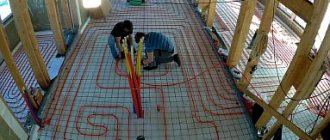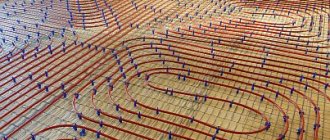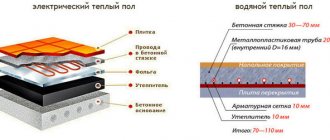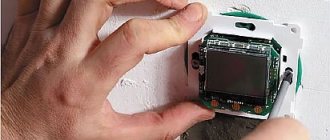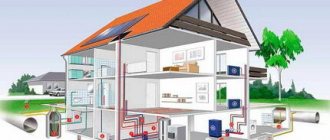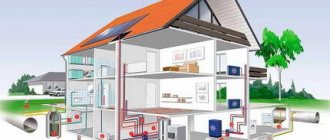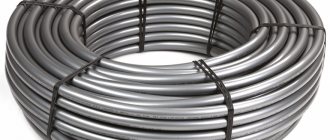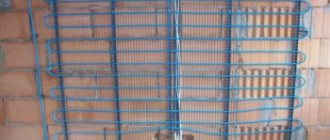A water heated floor is a complex and expensive engineering system, the effectiveness of which depends on many factors. And if you don’t know at least the basic nuances, you can suffer significant losses and subsequently seriously regret the useless expenses.
To prevent this from happening, you first need to understand the question of what are the pros and cons of heated floors with liquid coolant and only then make a decision about their installation. If you have any doubts, it is better to contact specialists to perform calculations and draw up an economic justification for the feasibility of installation.
Energy efficiency
According to current standards, the coolant temperature in these systems should not exceed 55°C. But in practice it rarely exceeds 40°C, especially when pipes for heated floors are tightly laid. As a result, the temperature difference between the supply and return lines is reduced and the energy consumption for heating the circulating water is reduced.
The entry of heat from below significantly reduces the useless heating of the upper layers of air, and the average temperature in the room decreases by 2-3°C, without deteriorating comfortable conditions.
The installation technology involves laying circulation pipes on heat-insulating mats and a foil backing for heated floors. This reduces energy loss by directing almost all the heat into the room.
As a result, the overall savings in thermal energy in a normally insulated house can reach 30-40%, and this figure can be further increased by 10-15% by installing an automated control system. If we assume the duration of the heating season to be 170-180 days, then the reduction in heating costs will be very significant.
Advantages of water-heated floors
The use of a water heating system through the flooring is based on the principle of conversion. In this regard, its main advantages include:
- A high level of efficiency of the heating system, which ensures uniform heating of the room without incurring unproductive costs for heating the ceiling and walls.
- The possibility of damage from hot surfaces of radiators is excluded;
- Lack of dust and pollution, which are inevitable during convective air movement.
- Protection from harmful organisms.
- Possibility of designed provision of temperature control in a separate room.
- Using a heated water floor for different types of coverings (laminate, parquet, tile)
- Due to the absence of radiators on the walls, interesting solutions in interior design appeared.
- Creating a comfortable environment not only in winter, but also in summer, cooling the room with cold water.
- A guarantee of health for the whole family, when you can walk barefoot in winter, and the air is clean and healthy.
The undoubted advantage of a warm water floor is its long service life. In this case, the service life depends only on the quality of the pipes used in this system. A low coolant temperature, which does not exceed 50°C, and in some cases 40°C is sufficient, reduces costs by an average of a third compared to using a traditional heating system.
Disadvantages of water heated floors
There are not many of them, but they still exist.
- Large initial costs A complex multi-layer floor structure will require the purchase of a large amount of materials, distribution equipment, pumps and the involvement of qualified specialists for their installation. Over time, the costs will be offset by lower heating costs, but you will have to pay a decent amount right away.
- Inertia of the system Initial heating of the floor array sometimes requires 2-3 days. In addition, high heating inertia can become a problem when there are large daily differences in outside air temperature. On the other hand, in the event of a power outage, pump or boiler breakdown, the floor will give off heat for another day or two, and during this time you can find a way to solve the problem.
- Space restrictions It is difficult to create a warm floor in a small room or a narrow corridor. However, experienced installers combine several such rooms into one system and resolve the issue. For example, a toilet, bath and corridor can be heated from one pipe.
What floor should we choose for a private home?
When choosing a warm floor for a private home, you need to take into account all the pros and cons, as well as the characteristics of the room and the strength of its floors. For cottages, screeded water floors are the most suitable and economical option. Despite the labor-intensive installation, their operation will be cheaper than electric ones.
However, if the building is wooden, with old floors, then this model is not suitable. Since the structure is heavy, and the floors may not withstand the additional load.
Then, it is recommended to install the pipeline not in a screed, but in a “dry” way, or opt for electrical types. The installation process is simpler, but operation will lead to increased energy costs.
Electric floors are a fire hazard, especially for wooden buildings, so if the floors allow it, it is better to install them in a screed.
Infrared floors in a private house are suitable only as additional heating, since their power is not enough to heat the entire building.
Which system is the safest and most reliable?
If you compare warm floors in terms of safety, the water circuit is undeniably better. There is no risk of short circuit or electric shock. Although cable and film floors of the modern generation have an increased degree of protection, this indicator is reduced to a minimum.
In terms of reliability, the heating cable is a high-quality product that has an increased warranty. Even low-cost wire can last up to 20 years. The temperature sensor and thermostat break down and need to be replaced more often.
In a water pipeline, the pipes themselves have a long service life, but the fittings have to be replaced after 10 - 15 years. To replace them, you will need to dismantle the concrete screed.
Which is more profitable and economical to operate?
Which warm floors are better and will cost less during operation is a question often asked by owners of private houses.
If we consider from the point of view of the price of the coolant, then water ones are definitely more economical. Heating the liquid inside the pipes will be much cheaper, especially if you have a gas boiler.
The price of energy that powers electric floors is steep, although with proper use of a thermostat, you can save on energy resources.
When comparing water and electric floors in terms of repair and maintenance costs, we can say that the cost of repair work in case of cable damage is lower than pipeline repair. And if water floors are laid on the second floor of the cottage, then if there is a serious leak in the circuit, the room below will need to be repaired.
Questions and answers
How much can you save if you install the system yourself?
For electric, the savings will be about 30% of the cost of materials and equipment, for water - 50-55%.
Which option to choose for wet rooms?
In bathrooms, kitchens, toilets and other rooms with high humidity, you cannot install only film heated floors. The rest work great even in such difficult conditions.
If the room has heavy furniture, which option should you choose?
As a rule, the issue with furniture is decided at the design stage - heaters are not placed under it. However, if it is possible to move the furniture after installing the heating system, you should choose the option of laying it in a screed - the likelihood of damage to the elements in this case is much less.
I have a small child, will the noise from the heating system bother him?
Modern heated floors of all types operate almost silently. In the case of a water pump, slight noise is possible when the pump operates and when air enters the circuit. The first problem can be easily solved by choosing the right location for the pump and manifold assembly, the second by including an air vent in the circuit.
Which option is preferable for a house on a garden plot?
If you do not live in it permanently in cold weather, it is better to choose a film one - it will quickly create a comfortable temperature. For permanent residence, one should be guided by the same considerations as for any private home.
Health effects
Is it enough to analyze the information on the query “water heated floor advantages and disadvantages” to make a final decision, especially if people with poor health live in the home? On the one hand, if the difficulties do not frighten you, but the advantages captivate you, it is worthwhile to critically evaluate them again.
The fact is that the very main feature and advantage of this type of heating, namely, a constant elevated floor temperature, which allows you to “keep your feet warm” all the time, can also have a downside.
Namely, it has a negative impact on the vascular system of the legs, because blood constantly rushes to the “warm” legs, putting a constant load on the veins and expanding them.
Therefore, it is recommended to install a water or electric floor in rooms with periodic and short-term presence of people there, or to limit the time they walk on the floor or stay on it.
The question of whether heated water floors are harmful to the general physical condition and well-being cannot be answered unambiguously. The air in the room is not too dry, there is no improper mixing of the layers, but in the case of heated floors, natural ventilation is difficult. In order to avoid air staleness, it is necessary to ventilate the room more often and take care of forced ventilation.
Reliability and durability
These indicators reflect the maximum permissible service life of the system and the probability of failure-free operation during this period, subject to installation and operating conditions.
For various underfloor heating systems they are:
- water - up to 50 years and more than 90%;
- core - 20-25 years at 70-75%;
- cable – 15 years and about 70%;
- film - 15 years, about 40%.
It should be noted that a water floor does not take into account the reliability and durability of the circulation pump, collector unit, and control equipment (pressure gauges, thermostats, etc.). All of them significantly (by 20-25%) reduce the above indicators.
Finishing coatings for different types of heated floors
It is important that the coverings for the heated floors are suitable. The following recommendations exist:
Preferable for a water floor:
- laminate;
- parquet;
- linoleum on a thin backing;
- ceramic tile;
- self-leveling floor
For an electric underfloor heating system we recommend:
- laminate;
- thin parquet;
- ceramic tiles;
- linoleum without insulation;
- self-leveling floor
For film electric heated floors, it is recommended to use laminate and uninsulated linoleum.
What does a heated floor system consist of?
It is impossible to say unequivocally that one system is better than another, because the effectiveness of each of them depends on many factors. Only after studying in detail the installation and operation conditions of both types, their pros and cons, will you be able to choose the most optimal option for your home. So, what are heated floor systems?
Electric heated floor
Electric heated floor
Electric heating systems are divided into film and cable.
The first option is a flexible thin sheet of special polyethylene with heating elements hermetically sealed into it. Thanks to its very simple design, anyone can install a film floor by just reading the manufacturer’s instructions. But only a qualified electrician should connect the system, despite the safety and simplicity of the device. The film floor is laid on a flat, insulated surface under the floor covering, without filling with screed or self-leveling mixtures. The temperature is controlled using a thermostat, and the connection is made to a regular electrical network with a standard voltage of 220 V.
Film heated floor
Teplotex kit
| Index | Meaning | Dimension |
| Specific power consumption | 170 | W/m2 |
| Width of thermal film CALEO GOLD | 50 | cm |
| Maximum length of one strip of thermal film | 10 | linear m |
| Melting point of thermal film | 130 | °C |
| IR heating wavelength | 5-20 | µm |
| The share of IR rays in the total spectrum | 9,40 | % |
| Anti-spark mesh | + | — |
| CALEO GOLD 170 W. Price | 1647-32939 (for sets from 170-0.5-1.0 to 170-0.5-20.0) | rub. |
| CALEO GOLD 230 W. Price | 1729-34586 (for sets from 230-0.5-1.0 to 230-0.5-20.0) | rub. |
An electric cable floor is a cable system with reflective thermal insulation, installation tape and an electronic thermostat. When installing, first lay the insulation with the foil facing up, then attach the mounting tape to it, and the cable is mounted on the tape. The thermostat is placed on the wall, the ends of the cable and the sensor are connected to it. After this, the heating elements are filled with screed or self-leveling compounds.
Rod infrared heated floor
Heated floor cable
Water floor
The water floor system consists of metal-plastic pipes, a control unit and a boiler. The heat is regulated both automatically and manually, thanks to the presence of a thermostat and thermostatic mixer in the system. The water supply is carried out from a riser or from a centralized heating system. Laying is done on an insulated, leveled surface, and the heating circuit is filled with screed on top. Installing a water floor requires appropriate skills and should therefore only be carried out by specialists.
Water floor - components
Operation of heated floors - rules and recommendations
A professionally designed and assembled water underfloor heating system is good because the term operation does not apply to it. The elements of this system are neither visible nor heard, but its effect is felt by the whole body - it’s just warm in the house.
Not somewhere near the radiator or in front of the fireplace. A house with water-heated floors is simply warm.
A comfortable state is ensured by the control system. The more complex and expensive it is, the more accurately you can adjust the heating modes and the speed of reaction to changing environmental conditions.
The only rule is scheduled replacement of the coolant and regular maintenance by specialists.
Disadvantages of floor heating with water coolant
If we talk about the disadvantages of such a heating system, then first of all, these are installation difficulties . The system itself consists of several layers, including waterproofing, cement-concrete screed, and floor covering made of decorative material.
Before laying pipelines, the subfloor surface must be thoroughly prepared and leveled. High initial costs, which are approximately five times higher compared to installing radiators or electric heating.
It is impossible to effectively use the technology of floor heating with water coolant in a room where there are many stairs, since it cannot be used on a landing. In an apartment building, it is prohibited to install a water-based floor heating system on high floors due to the fact that this significantly increases the hydraulic resistance.
Another disadvantage of installing a water floor is its significant impact on the level of air humidity , which requires the installation of an air humidifier. Installation work is recommended to be carried out during the construction of a house or during major renovations. A water heated floor leads to a significant increase in the floor level, which also needs to be taken into account with such a heating system.
Maintainability
From the point of view of repair when part of the system fails, heated floors can be characterized by:
- Rod is the best option. Firstly, the failure of one rod does not lead to the failure of the entire system (the elements are connected in parallel). Secondly, for repairs it is enough to cut out a section of the current-carrying bars with a non-working rod and mount another one in its place.
- Vodyanoy . The material of the pipelines allows the removal of the damaged section and its replacement with a new section of pipe. The biggest problem arises when installing in a screed - the amount of work increases significantly.
Electric options are usually the most repairable
- Film . Similar to the rod, you can replace the film section. It is inferior to the rod one for only one reason - when dismantling the finishing coating there is a danger of damaging several sections.
- Cable . Cannot be repaired - manufacturers of resistive cables prohibit the replacement of sections; the entire heating element will have to be replaced.
A good method of solving problems with a cable floor is to section it at the installation stage. By dividing it into sections, connecting them in series and in parallel, you can provide the required power of the heat source and significantly increase maintainability - only the failed section will require replacement.
Infrared film floors
The system is based on a carbon layer that covers the film. On the sides the sheets are framed with a copper busbar. It works on the principle of heating a carbon layer with electricity, followed by heat release to the external environment.
We recommend: Why is Valtek pipe good for underfloor heating?
General advantages:
- resistant to sudden temperature changes;
- IR film heats up quickly.
The downside is the rapid cooling of both film and rod sheets.
Infrared film floors
Infrared floors are divided into…
Film:
- the system is quick and easy to install;
- during dismantling, it is possible to reuse the removed structure;
- if a separate part of the system breaks down, the entire circuit will not stop functioning, since the parts are not interconnected and do not depend on each other;
- The film can be easily divided into parts of the required sizes for ease of installation, both in small passages and in large rooms.
Minuses:
- You need to choose your flooring wisely, as it may be too thin or too thick. In the first case, it may be deformed, in the second, the heating efficiency will be reduced;
- The heated floor must be laid on a completely dry surface.
Rod:
- automatic increase and decrease in energy efficiency due to increased or decreased ambient temperature;
- Laying under large pieces of furniture is permitted. Overheating is excluded;
- even if two or more parts fail, the system will function properly.
Disadvantage: mats cannot be combined with a foil backing, since due to the interaction of individual elements, both the film and the backing will be deformed.

